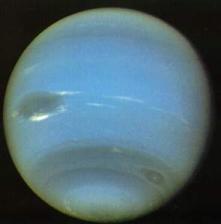
![]() Main Page
Main Page
![]() Feedback
Feedback
 The Author
The Author
 News
News
 Search
Search
 The Planets
The Planets
 Mercury
Mercury
 Venus
Venus
 Earth
Earth
 Mars
Mars
 Jupiter
Jupiter
 Saturn
Saturn
 Uranus
Uranus
 Neptune
Neptune
 Pluto
Pluto
 Dwarf Planets
Dwarf Planets
 The Solar System
The Solar System
 The Sun
The Sun
 The Moon
The Moon
 Meteors
Meteors
 Comets
Comets
 Asteroids
Asteroids
 Amazing facts
Amazing facts
 Other
Resources
Other
Resources
 Poster Store
Poster Store
 Multimedia
Multimedia
 Links
Links
 Awards
Awards
 Glossary
Glossary
 Astronomers
Astronomers
 Webrings
Webrings
 Bibliography
Bibliography

Technical Data:-
| Diameter | 49,528 km |
| Average Distance from Sun | 4,501 million km |
| Mass | 1.02 x 1026kg |
| Size compared to Earth | 3.8x |
| Gravity compared to Earth | 1.2x |
| Cloud-Top Temperature | -220°C |
| Length of Day | 16.11 hours |
| Length of Year | 164.8 Earth years |
| Eccentricity of Orbit | 0.009 |
| Moons | 8 |
| Density | 1.76 gm/cm3 |
| Atmosphere | Hydrogen - 85% Helium - 13% Methane - 2% |
More pictures of Neptune Here |
Print this information out Here |
|||||||||||||
| ||||||||||||||
Of the four 'gas giants' that inhabit the outer Solar System, Neptune is both the smallest and the furthest from the Sun - the last major gaseous outpost before Pluto and the Kuiper Belt. As such it has never been observed in detail by a dedicated orbiter. Nontheless, in 1989 the Voyager 2 spacecraft supplied much information and many pictures about this distant, mysterious world, before it raced past it into the outer reaches of the solar system. Neptune was in fact the first planet to be 'predicted', and then subsequently observed. John Adams and Joseph Le Verrier independantly proposed an orbit for the planet in 1845, based on peculiarities in Uranus' orbit, and observations a year later by German astronomer Johann Galle confirmed this prediction. Named after the Roman God of the Sea Neptune is certainly reminiscent of sealike colours, as it appears a shade of blue-green to us from space. Underneath Neptune's atmosphere however, scientists believe there to be an ocean of liquid methane and ice slush surrounding a rocky core. The reason for Neptune's blue colour however is essentially the same as for Uranus - because the Methane in the planet's atmosphere absorbs red light, so the sunlight reflected back to us from the atmosphere is predominantly blue. Neptune's atmosphere extends very far down, eventually merging into water and other melted ices, above its liquid outer core, which is approximately the same size as the planet Earth. It is assumed that the composition of Neptune is similar to that of Uranus, so we're looking at a uniform distribution of elements, rather than the internal layering which characterises Jupiter and to a lesser degree Saturn. Interestingly, Neptune's winds are up to nine times stronger than those on Earth, and three times stronger than those on Jupiter, despite its low energy input and great distance from the Sun. Neptune is quite similar to Jupiter in that it has several oval hurricanes. It also has one 'Great Dark Spot' which, like Jupiter's famed Great Red Spot is a massive hurricane/storm. Unlike the Red Spot though, it seems to have recently vanished from view, leaving Astronomers unsure as to whether it still exists. Not much was known about Neptune before it was visited by the Voyager space probe, which made many interesting discoveries, for instance it cleared up the 'Neptune arc' problem. When viewed from Earth, faint arcs were spotted around Neptune, but Voyager showed that there are actually three complete rings around the planet, which vary in thickness. Neptune's rotational axis is tilted at a large 30° to the plain of its solar orbit, and consequently the planet experiences some rather extreme seasons, each lasting 41 years. During its 'summer' season therefore, each pole is in constant sunlight for 41 years! Due to the very elliptical nature of Pluto's orbit, on certain occasions Neptune can end up being further away from the Sun than Pluto, as its orbit cuts across Neptune's. On average however, Neptune's orbit is a massive 4,500 million km away from the Sun - 30 times the distance between the Sun and the Earth. Neptune's eight moons are: Naiad, Thalassa, Depoina, Galatea, Larissa, Proteus, Triton and Nereid. The most interesting is Triton which has many geyser-like eruptions, spewing invisible Nitrogen gas and dust particles many kilometres into the atmosphere. It's an icy world of frozen methane just 2720 km wide - smaller than Earth's moon! To find out more look at our Triton section. |
||||||||||||||
Extended Reading:- |
||||||||||||||
More info on Neptune's moon Triton |
||||||||||||||
Brief History:- |
||||||||||||||
Neptune was predicted in 1845 by British mathematician John Adams and French mathematician Jean Leverrier by clever observations of Uranus' orbit. One year later, in 1846, German astronomer Johann Galle confirmed what the mathematicians thought by finding it using Adams and Leverrier's predictions. In the same year, Triton was discovered by British astronomer William Lassell. Its rings were discoverd nearly a century and a half later, in 1985 and Voyager 2 discovered six more satellites in 1989. |
||||||||||||||
Neptune Links |
||||||||||||||
|
||||||||||||||

Neptune
Buy this Poster at AllPosters.com